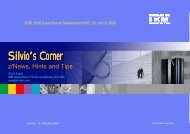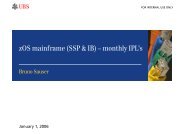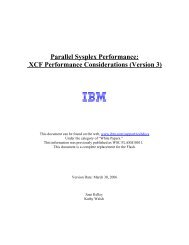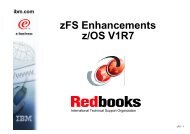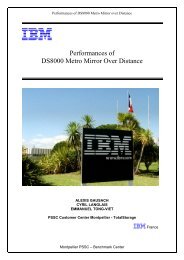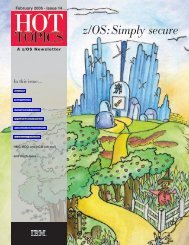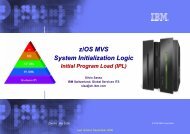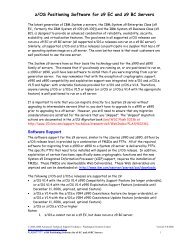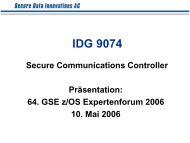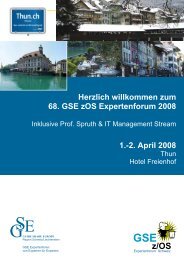Migrating to zOS R8 Part 1 - Messmer The Brain House
Migrating to zOS R8 Part 1 - Messmer The Brain House
Migrating to zOS R8 Part 1 - Messmer The Brain House
Create successful ePaper yourself
Turn your PDF publications into a flip-book with our unique Google optimized e-Paper software.
z/OS <strong>R8</strong> Coexistence<br />
z/OS<br />
R4<br />
z/OS<br />
R5<br />
<strong>Migrating</strong> <strong>to</strong> z/OS <strong>R8</strong> <strong>Part</strong> 1 of 3: Get Ready<br />
z/OS<br />
R6<br />
z/OS<br />
R7<br />
Starting with z/OS R6, IBM has aligned the coexistence, fallback, and<br />
migration policy with the service policy.<br />
z/OS R5, z/OS R6, z/OS R7, and z/OS <strong>R8</strong> are supported for coexistence, migration, and<br />
fallback<br />
Prepare now! <strong>The</strong> lowest release planned for coexistence, migration, and fallback support on<br />
z/OS <strong>R8</strong> is z/OS R5. If you are on z/OS R4 you should be planning for your migration <strong>to</strong> z/OS<br />
R7!<br />
Only JES2/JES3 that can coexist with the shipped JES can be "staged" on<br />
z/OS. This is enforced in z/OS V1 <strong>R8</strong>. That means:<br />
z/OS R5 JES2 thru z/OS <strong>R8</strong> JES2 are supported for coexistence, migration, and fallback<br />
z/OS R5 JES3 thru z/OS <strong>R8</strong> JES3 are supported for coexistence, migration, and fallback<br />
<strong>Migrating</strong> <strong>to</strong> z/OS <strong>R8</strong> <strong>Part</strong> 1 of 3: Get Ready<br />
© 2003 IBM Corporation<br />
© 2006 IBM Corporation<br />
Understanding Coexistence<br />
Coexistence occurs when two or more systems at different software levels share resources. <strong>The</strong> resources could be<br />
shared at the same time by different systems in a multisystem configuration, or they could be shared over a period of time<br />
by the same system in a single-system configuration. Examples of coexistence are two different JES releases sharing a<br />
spool, two different service levels of DFSMSdfp sharing catalogs, multiple levels of SMP/E processing SYSMODs<br />
packaged <strong>to</strong> exploit the latest enhancements, or an older level of the system using the updated system control files of a<br />
newer level (even if new function has been exploited in the newer level).<br />
<strong>The</strong> sharing of resources is inherent in multisystem configurations that involve Parallel Sysplex implementations. But<br />
other types of configurations can have resource sharing <strong>to</strong>o. Examples of configurations where resource sharing can<br />
occur are:<br />
� A single processor that is time-sliced <strong>to</strong> run different levels of the system, such as during different times of the day<br />
w A single processor running multiple images by means of logical partitions (LPARs)<br />
w Multiple images running on several different processors<br />
w Parallel Sysplex or non-Parallel Sysplex configurations<br />
Note: <strong>The</strong> term coexistence does not refer <strong>to</strong> z/OS residing on a single system along with VSE/ESA, VM/ESA, or z/VM in<br />
an LPAR or as a VM guest.<br />
z/OS systems can coexist with specific prior releases. This is important because it gives you flexibility <strong>to</strong> migrate systems<br />
in a multisystem configuration using rolling IPLs rather than requiring a systems-wide IPL. <strong>The</strong> way in which you make it<br />
possible for earlier-level systems <strong>to</strong> coexist with z/OS is <strong>to</strong> install coexistence service (PTFs) on the earlier-level systems.<br />
You should complete the migration of all earlier-level coexisting systems as soon as you can. Keep in mind that the<br />
objective of coexistence PTFs is <strong>to</strong> allow existing functions <strong>to</strong> continue <strong>to</strong> be used on the earlier-level systems when run<br />
in a mixed environment that contains later-level systems. Coexistence PTFs are not aimed at allowing new functions<br />
provided in later releases <strong>to</strong> work on earlier-level systems.<br />
SHARE (c) Copyright IBM Corporation, 2006 August 15, 2006<br />
Session 2870 Page 30 of 70 Baltimore, MD<br />
z/OS<br />
<strong>R8</strong><br />
z/OS<br />
R9<br />
z/OS<br />
R10<br />
18



